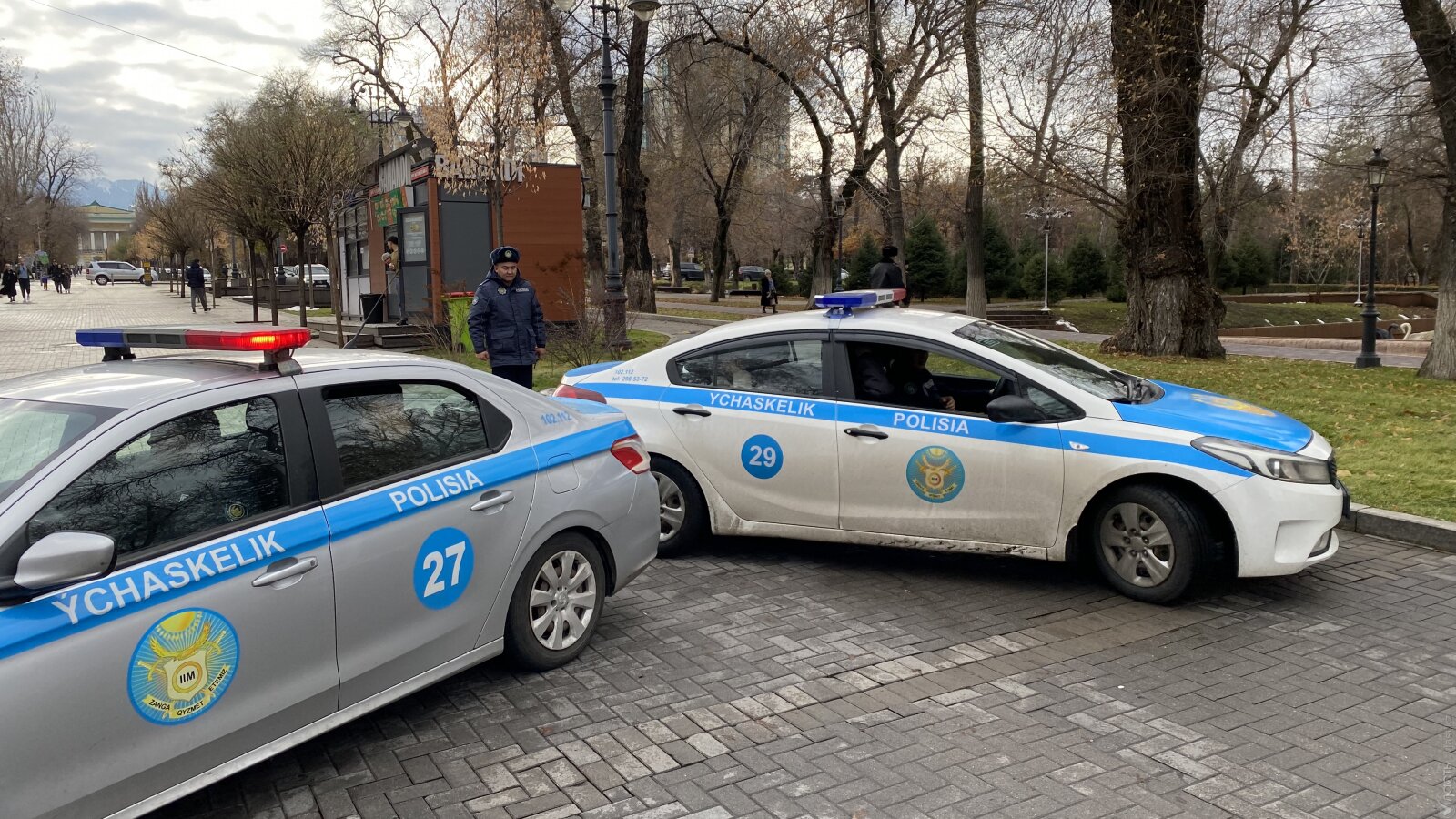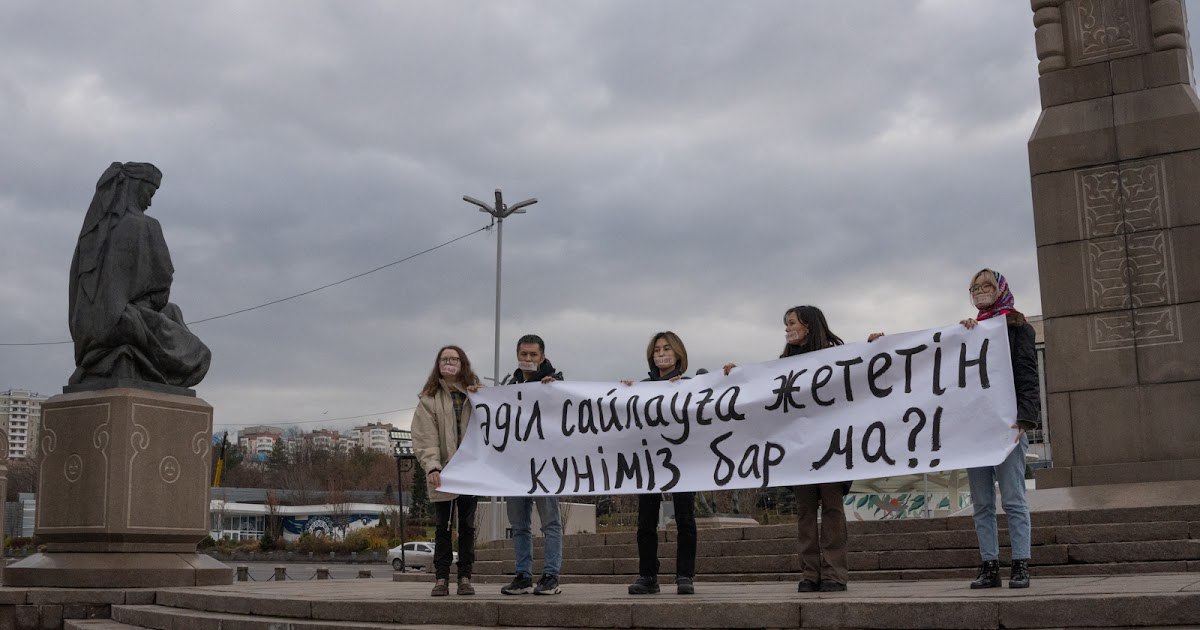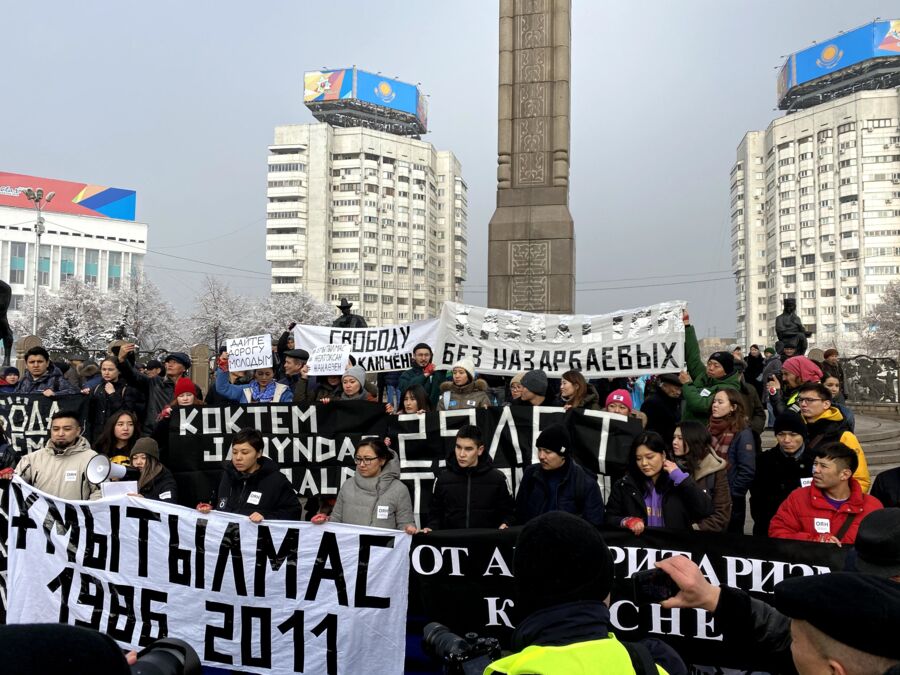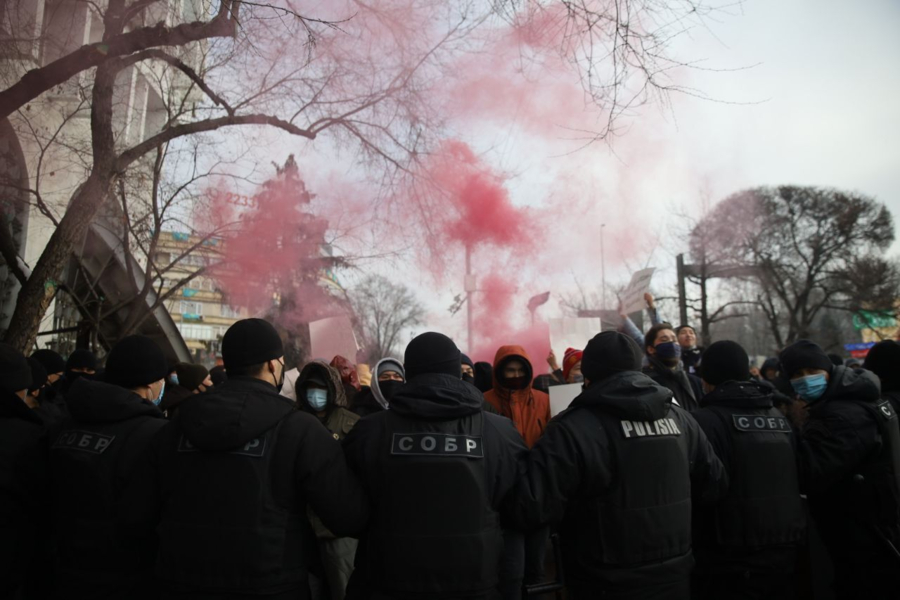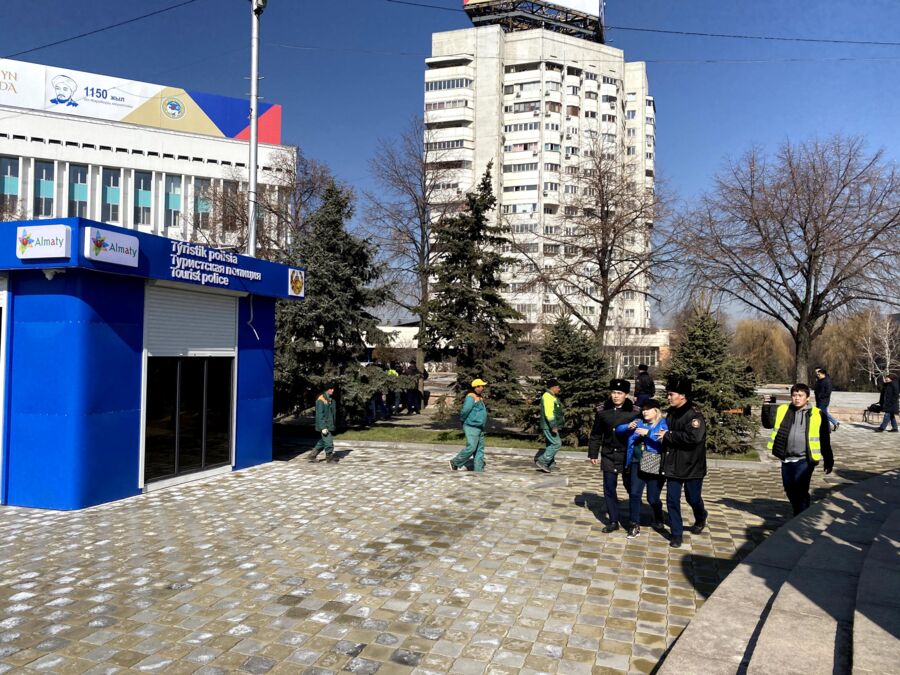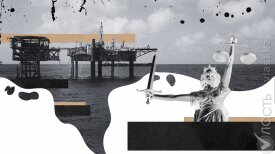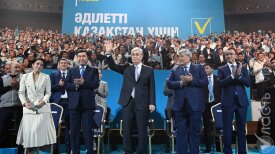Around 200 police and security officials stood around the so-called Old Square in Almaty, Kazakhstan’s largest city, around noon on November 20, election day. They were expecting protests by activists from the Democratic Choice of Kazakhstan (DVK), a banned political organization funded by fugitive ex-banker Mukhtar Ablyazov, now living in France.
The usual shouting, banners, slogans were neither seen, nor heard this time.
Smug, yet bored, the chief of police ordered at least nine arrests, pointing to known DVK sympathizers and other passers-by.
Detentions, in the Old Square and elsewhere on Election Day, were all quiet, with a disproportionate show of force, as at least a dozen officials surrounded and dragged activists into police cars and vans. One elderly man was helped into a police car as he slowly stood up from a bench he was sitting on.
Around 30 people were arrested on election day in Kazakhstan. Effectively, however, only around two dozen activists came out to protest in Almaty in three different points of the city. Five sympathizers of the unofficial Democratic Party and ten members of the youth movement Oyan, Qazaqstan! demonstrated their dissatisfaction with the political situation in the country and were promptly arrested.
In comparison, dozens, sometimes hundreds of people used to be arrested at election time during protests in previous years.
Cynical, Tired, or Scared?
Judging by the shrinking number of people in the streets, an observer could conclude that political activism is waning across the country. Some point to a growing apolitical sentiment. According to several analysts, however, one of the main reasons is the experience of Qandy Qantar, the bloody repression of street protests at the beginning of the year, which came on the back of an inconstant wave of protest and repression.
Between 2018 and early 2019, the DVK was the only political movement that actively demonstrated in the streets. Because it was linked to Ablyazov, then-President Nursultan Nazarbayev’s arch-enemy, their protests were promptly repressed, their sympathizers were tracked online, and the government’s intimidation had anyone scared to be even mistakenly seen as affiliated with them. At one point, parents were discouraged from buying their children blue balloons, as they had become a DVK symbol.
When Nazarbayev resigned in 2019, the political situation in the country seemed to open up a space for an alternative to the system that he had created during his three decades in power. Despite a different rhetoric under Tokayev, however, rallies and demonstrations organized by various groups were firmly disbanded and their activists pressured into refraining from public activity.
According to Colleen Wood, lecturer at Columbia University and researcher of civic engagement in Central Asia, “smaller protests leading up to the 2019 elections spiraled into large crowds who wanted to voice their frustration with the facade of choice. In 2019 there was a certain level of uncertainty about the power transition from the Nazarbayev regime. Conversely, these elections were a way for Tokayev to fix his hold on power. ”
On Sunday, Tokayev won with 81% of the consensus.
Marius Fossum, regional representative in Central Asia at the Norwegian Helsinki Committee, a human rights organization, regularly witnesses the protests in Almaty. He said that the protest mood has waned after Qandy Qantar.
“When Tokayev first ran for office in the summer of 2019, the public was emboldened in part by the ostensible power transformation, which partially explains why that election drew considerably more protesters to the streets. But of course that election was not preceded, like this one, by the national trauma that is January 2022,” Fossum told Vlast.
Wood agreed about the consequential effects of Qandy Qantar and told Vlast that Election Day was not the only moment of traditional public engagement that saw little presence on the streets.
“This year, the specter of Bloody January has hung over days that have been flashpoints for protest for years – not only during elections, but also for national holidays like Constitution Day,” Wood said.
Political protests had occurred repeatedly until early January and the trauma of Qandy Qantar could have had a negative effect on the people’s willingness to protest. Possibly, a presidential election was not going to be the turning point of public activism this year, Diana Kudaibergenova, assistant professor in Political Sociology at the University of Cambridge told Vlast.
Fossum added that the lack of protest on this occasion is not an indication that society is growing less political.
“It seems that a presidential election just won’t spark considerable engagement either way, although it certainly doesn’t exclude large displays of public protests in the near future,” Fossum said.
On their part, activists told Vlast that there have been several small-scale protest actions and that their work has continued even without a public display.
Not Crime, But Punishment
The space for political activism, meanwhile, is shrinking. This has to do with repressive tactics against political opponents and the co-optation of potential alternative figures. Stringent control and monitoring of activists' work, together with the sheer material costs associated with political activism, have hindered the movements’ ability to attract new members.
Since 2019 the government’s strategy has focused on suppressing any public display of dissent. Before and after the 2019 presidential elections, the protest sentiment was also visible in the numbers. Public rallies continued, and by the end of the year, for Independence Day, a larger-than-usual crowd gathered in Republic Square, which would later be the theater of the worst clashes during January 2022.
At its height, the COVID-19 pandemic seemed to slow down public gatherings, but some protests were still carried out in Almaty by different opposition groups.
Discontent, galvanized by the economic slowdown due to the pandemic and the sharp fall in oil prices, simmered below the surface, while the government said it eased the legislation on public gatherings. With a May 2020 law, groups no longer need to apply to obtain permission from the authorities to organize a public assembly, they only need to notify the local administration three-to-seven days in advance and wait for approval.
While this is heralded as progress towards democracy by the government, the law only considers valid applications from registered associations and groups. An informal movement such as Oyan, Qazaqstan!, or an unregistered party like Zhanbolat Mamai’s Democratic Party, would not be able to organize a public gathering under these rules.
In June 2020, one protest was hindered and dispersed by the police with the help of “street sanitizers”, who purportedly were called to sanitize the street corners around the iconic Hotel Kazakhstan exactly at the time that the Democratic Party had called a protest in the same area.
Instead of facilitating public gatherings as an outlet of discontent, the new legal framework has effectively increased repression against so-called “unregistered associations”. On the squares, their members are now immediately notified by the local government officials and then promptly detained and taken to a police station. In some cases, like during Independence Day protests in December 2020, special police forces employed the so-called “kettling” tactic, by which they surrounded the few dozen protesters for hours without allowing them to leave.
The following year, in December 2021, there were almost no displays of public protests, possibly because of the people’s unwillingness to face a certain, harsh punishment. On December 16, several hundred policemen and special forces oversaw a few dozen activists, who quietly remembered the people killed in 1986 and 2011. Another quick flash mob by a handful of Oyan activists made the rounds on social media, as other Oyan activists had been detained just before the performance.
The haphazard setup of the protests in January clearly represented an outlier in the public outpouring of dissent. Yet, the authorities’ strong-armed repression was consistent, if not harsher with the zero-tolerance policy of the previous years. The show of force by the authorities during Qandy Qantar resulted in thousands of arrests, hundreds of injured people, and 238 killed across the country.
Since then, public gatherings have been few and far between. The latest large rally was held in March, but it was strictly to protest the Russian invasion of Ukraine and was both sanctioned and conducted in a designated space for rallies in Almaty.
Micro-Protests Are Protests Too
All other moments of protest since then were small in size. On voting day for the referendum in June, Darkhan Sharipov, an activist from Oyan, staged a one-person picket with a poster saying “Qandy Qantar 2022 - Impossible to Forget”. Sharipov was quickly arrested and detained for a few hours. On the same day, two Democratic Party activists staged a short demonstration at one polling station in Almaty, demanding the release of their leader, Zhanbolat Mamai, who has been in pre-trial detention since February. The activists were immediately warned of the illegality of their actions, but were not ultimately detained.
On November 14, a handful of Oyan activists applied a “Qantar” street sign on Nazarbayev street, demanding that the main urban artery in Almaty be renamed in remembrance of the victims of Bloody January (a QR-code attached to the sign linked to a website listing all victims). Once called Furmanov Street, the main North-South artery in the center of Almaty was renamed in honor of Nazarbayev already in 2017, when he was still president.
After witnessing the performance, the police removed the sign.
Wood believes that these micro-demonstrations could prove powerful in maintaining activists engaged, especially around important dates, such as the constitutional referendum or the presidential elections.
“Mass protest is not the only way that people demonstrate dissent. Some activists that have been affiliated with Oyan called for people to either vote ‘against all’ or ruin their ballot – and in contrast to reports of more than 80% turnout [in some regions], fewer than 29% of eligible Almaty voters cast a ballot,” Wood told Vlast.
Further protests could emerge because of unresolved issues of social justice and lagging democratic reforms, Kudaibergenova argues.
With large gatherings hindered by a stringent law and the people’s trauma after Bloody January, micro-protests, flash mobs, and one-person pickets have become a more customary way of publicly demonstrating dissent.
The government is certain that the “New Kazakhstan” policies have guaranteed better public participation, also citing the May 2020 law on public assembly. “Officials have told us that the police are instructed to detain protesters without unnecessary force,” Fossum, who monitors human rights abuses, said.
Yet, in his January 7 address to the nation at the height of the Bloody January repression, Tokayev accused activists of abusing the freedoms that they had just obtained a couple of years before.
“Some so called ‘human rights defenders’ and ‘activists’ put themselves above the law and believe that they have the right to gather where they want and say what they want,” Tokayev said, just after having warned the public that he had ordered the law enforcement apparatus to shoot-to-kill without warning against the “terrorists” that he argued had taken over the streets of Almaty.
For years, the government employed a wide range of tactics to discourage activists and exhaust them, with surveillance, threats, detentions, and kettling circles. In January, it discredited them, detained them, and shot at them.
According to official data, on Election Day, just at the polling stations, 20,000 police were deployed. Accounting for those already in detention and those who came out to protest, this massive display of force had to face fewer than one hundred activists.
The disproportion in numbers only allows for small-scale protests by activists who are willing to be, at minimum, dragged away, detained for a few hours and fined. The certainty of punishment and the terror of a disproportionate reaction like in January have almost shut down street political activism.
Whether grassroots or organized through political parties, dissent is a key part of the democratic process. Despite a constitutional right to peaceful assembly, in order to express dissatisfaction Kazakhstanis have been cornered into carving their own spaces, where they still face a dire repression.
Поддержите журналистику, которой доверяют.
